 |
Left: Journal cover of Légitime Défense (Self-Defense) (1932).
Right: Adam Pendleton (American, b. 1984) with Jaan Evart (Estonian, born 1981),
Marc Hollenstein (Swiss, b. 1980). Black Dada (Ian Berry, couple dancing, independence
celebration Congo, 1960) (2008/2012). Courtesy the artist, Pace Gallery,
and Shane Campbell Gallery. |
Blizzard Nemo struck, but it wasn't a knockout blow, so I bundled up and hopped on the trains to make my way to
NYU on Saturday so as not to miss a
Performa conference with one of the longest titles I've ever seen,
GET READY FOR THE MARVELOUS: BLACK SURREALISM IN DAKAR, FORT-DE-FRANCE, HAVANA, JOHANNESBURG,
NEW YORK CITY, PARIS, PORT-AU-PRINCE, 1932-2013, but which could easily go by the title "Marvelous Black Surrealism(s)." Held at NYU's Barney Building, the conference included the standard talks and panel discussions, but also film screenings and several performances. Since I attended the
MoMA PS1 Now Dig This! conference on Friday I had to miss the conference's first day, which RoseLee Goldberg, the Founding Director and Curator of Performa introduced, and which included a keynote address by
Robin D. G. Kelley, "Blues People and the Poetic Spirit:
Recovering Surrealism's Revolutionary Politics; artist
Adam Pendleton's "Black Dada" performance honoring playwright Adrienne Kennedy; a panel on "Black Surrealist Beginnings: Dance, Theater, and Visual Art," featuring NYU professor
Awam Ampka and
Barbara Browning; Lowery Stokes Sims, Curator at the
Museum of Art and Design; and RoseLee Goldberg; a screening of
Maya Deren's famous film (completed by Cherel Ito and Teiji Ito),
Divine Horsemen: The Living Gods of Haiti (1985). Poet
Holly Bass, who I saw on the Saturday, told me that the panel was especially good.
Saturday's program began with a screening of the
William Greaves' 1967 film
The First World Festival of Negro Arts; this was the official documentary film of the 1966 festival held in Dakar, Senegal, attended by over 2,000 artists in all genres from across the African Diaspora, among them
Duke Ellington, Langston Hughes, Alvin Ailey, Léopold Sédar Senghor, and
Aimé Césaire. Following the Greaves film was
Zétwal, a 2008 film by
Gilles Elie-dit-Cosaque, which tells the story of
"Martinican legend" Robert Saint‐Rose, or
Zétwal (Creole for
Les Étoiles, or Stars, or "Twinkl," as it was translated in the subtitles), who built a space-ship and attempted to travel to outer space, powered by the poetry of Césaire. As fanciful as this sounds--and bizarre, no less--the film tells an enthralling story about popular beliefs, the credence given the written and spoken word, specifically poetry and more specifically the poetry of Césaire, and how myths shape and become realities. This film repeated in the afternoon when, because of the blizzard,
Savannah College of Art and Design chief curator
Isolde Brielmaier was unable to make it to New York to deliver her talk on contemporary artist
Wangechi Mutu.
The afternoon session did begin in fulgurant fashion with NYU performance studies guru
Tavia Nyong'o delivering a paper entitled "Dream, Collage, Lightning: Dark Future for Surrealism." There were so many bright points in this presentation that I could barely keep up, but I did note a few: the idea of "illuminatory fulguration" in relation to capital, surrealism, and the future; thinking of the "black in black surrealism as the back beat"; the work of the
Brazilian artist
Washington Silveira; the "ongoing immanence of blackness to European radicalism"; how
Jean-Michel Basquiat, in "Cabeza" and other paintings, was drawing upon a notion of "The Line of Flight" from
George Jackson and other black radicals, and how this linked to even older trajectories of flight and fugitivity;
Lorraine O'Grady--evoked several times during the day--on the feminine body in the West not being a "unitary sign," but rather like a 2-sided coin, which led to thinking about how blackness and racial difference made possible the "sexual differentiation of sexual difference," which is to say that blackness "provides the dark ground on which sexual difference can differentiate itself"; Mutu's art building figures out of the body's palimpsests; blackness as the possibility of all colors or euchromaticity;
Fred Moten (also frequently evoked) noting that "we claim all who claim blackness"; and, a revelation for me, the work of
Regina José Galindo, notably a body art-performance piece in which she covered herself in multiple layers of blackened cork, curled up like a ball, and then remained impassive as two men, followed a woman, urinated on her. Nyong'o talked about how he withheld identification with her in order to "see" the performance, see her, see more deeply into what meanings it held and offered, and concluded by tying this to the old(er) idea of surrealist "second sight," which might allow us more fully to "see."
Another highlight of the day was a conversation
Paul D. Miller, a/k/a DJ Spooky, held with filmmaker, director, actor and overall savant
Melvin Van Peebles. Up there in years but spry as a fox, Van Peebles told stories, recited some poems, and basically served up a bounty of folk wisdom, even sharing the famous "Shine on the Titanic" poem, which I hadn't heard in years. In between anecdotes about how he, a native of the South Side of
Chicago, got started initially as a painter before shifting into films, dealing with mainstream studios and the unions, and his role in helping
Gordon Parks to get his first directing stint in
Hollywood, he expounded on how so much of black life in America and elsewhere has drawn upon a practical surrealism that functions as a means of survival. It was a highlight of the afternoon. Another came when author, musician, cultural critic, and brilliant person
Greg Tate concluded the afternoon panel on "Black Surrealism Now," which also included artist
Simone Leigh, and
Gabi Ngcobo, Curator and Founder of the
Center for Historical Reenactments in
Johannesburg, with what may have been a work of fiction that also moved critically across a range of themes and tropes dealing with what he variously named "black soul realism" and "Afro-fugitivism." I would be remiss if I didn't mention doctoral student and associate curator at Peforma Institute
Adrienne Edwards, who not only organized the entire conference, but offer the warm remarks throughout the day and delivered a stand-in, stand-up presentation on Mutu, casting insightful light on that artist's works. All the events were videotaped, so I hope Performa makes them available free of charge, and soon.
Some photos from the event below:
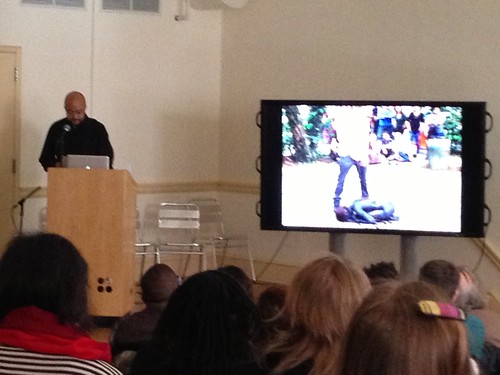 |
| Tavia Nyong'o, with a clip of Regina Galindo |
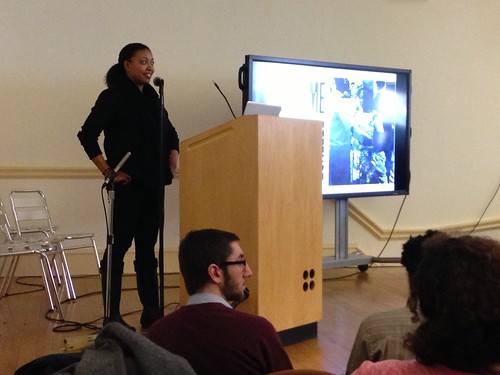 |
| Conference organizer and presenter Adrienne Edwards |
 |
| DJ Spooky and Melvin Van Peebles |
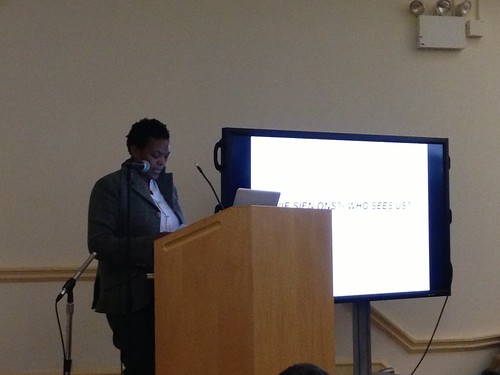 |
| Gabi Ngcobo |
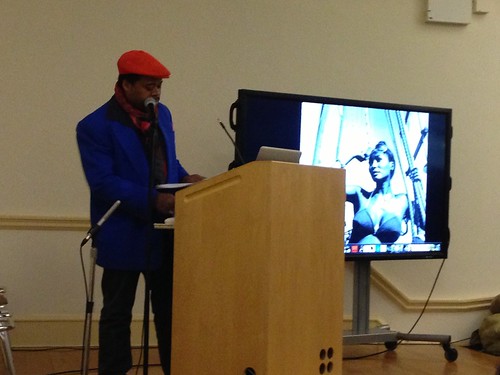 |
| Greg Tate |
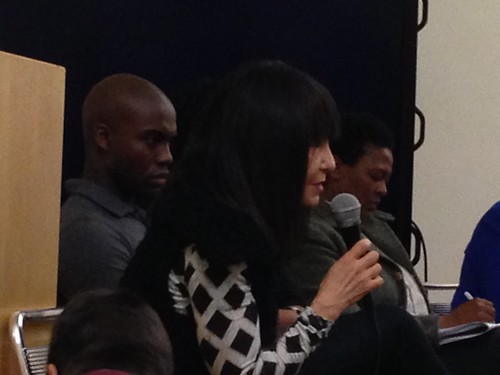 |
| Final panel (l-r) Adam Pendleton, RoseLee Goldberg, Gabi Ngcobo |
















No comments:
Post a Comment